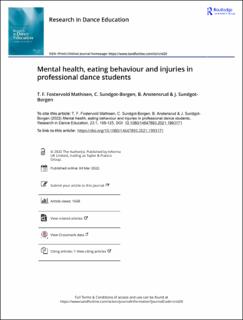| dc.contributor.author | Mathisen, Therese Fostervold | |
| dc.contributor.author | Sundgot-Borgen, Christine | |
| dc.contributor.author | Anstensrud, Beate | |
| dc.contributor.author | Sundgot-Borgen, Jorunn | |
| dc.date.accessioned | 2022-08-04T11:27:41Z | |
| dc.date.available | 2022-08-04T11:27:41Z | |
| dc.date.created | 2022-03-04T17:32:22Z | |
| dc.date.issued | 2022 | |
| dc.identifier.citation | Research in Dance Education. 2022, 23(1), Side 108-125. | en_US |
| dc.identifier.issn | 1464-7893 | |
| dc.identifier.uri | https://hdl.handle.net/11250/3010140 | |
| dc.description | This is an Open Access article distributed under the terms of the Creative Commons Attribution-NonCommercial-NoDerivatives License (http://creativecommons.org/licenses/by-nc-nd/4.0/), which permits non-commercial re-use, distribution, and reproduction in any medium, provided the original work is properly cited, and is not altered, transformed, or built upon in any way. | en_US |
| dc.description.abstract | A high frequency of mental health challenges and injuries in professional dancers necessitate a better understanding of the complexity of such symptoms, and to explore differences according to sex, academic year and performance levels. Professional dance students were recruited to evaluate symptoms of depression and anxiety (SCL-10), resilience (RSA), self-esteem (RSS), perfectionism (CAPS), body appreciation (BAS-2), and symptoms of low energy availability (LEA, LEAF-q) and eating disorders (ED) (EDE-q). Totally 20–54% of the dancers had symptoms of anxiety or depression, LEA (in females), ED and/or injuries, and 12% had a self-reported history with ED. In females, 44% of the variability in SCL-10 was explained by CAPS and RSS; 15% of variability in LEA was explained by EDE-q and training volume; while BMI, academic year and LEA increased the odds ratio of an injury. In all, BAS-2 reduced the odds ratio of EDE-q by -3.33. Totally 50% reported that they could identify personal mental health problems, still <45% would consult a health professional. Enhanced body acceptance may reduce the frequency of mental health challenges in dancers, and improved knowledge of nutrition and body weight regulation may reduce the high frequency of LEA, disordered eating behaviour, and injuries. | en_US |
| dc.language.iso | eng | en_US |
| dc.relation.uri | https://www.tandfonline.com/doi/full/10.1080/14647893.2021.1993171 | |
| dc.subject | ballet | en_US |
| dc.subject | body appreciation | en_US |
| dc.subject | contemporary | en_US |
| dc.subject | dance | en_US |
| dc.subject | depression | en_US |
| dc.subject | eating disorders | en_US |
| dc.subject | energy availability | en_US |
| dc.subject | jazzdance | en_US |
| dc.subject | perfectionism | en_US |
| dc.subject | self-esteem | en_US |
| dc.title | Mental health, eating behaviour and injuries in professional dance students | en_US |
| dc.type | Peer reviewed | en_US |
| dc.type | Journal article | en_US |
| dc.description.version | publishedVersion | en_US |
| dc.rights.holder | © 2022 The Author(s) | en_US |
| dc.source.pagenumber | 108-125 | en_US |
| dc.source.volume | 23 | en_US |
| dc.source.journal | Research in Dance Education | en_US |
| dc.source.issue | 1 | en_US |
| dc.identifier.doi | 10.1080/14647893.2021.1993171 | |
| dc.identifier.cristin | 2007739 | |
| dc.description.localcode | Institutt for idrettsmedisinske fag / Department of Sports Medicine | en_US |
| cristin.ispublished | true | |
| cristin.fulltext | original | |
| cristin.qualitycode | 2 | |
